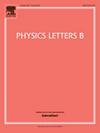Heavy-light mesons from a flavour-dependent interaction
IF 4.3
2区 物理与天体物理
Q1 ASTRONOMY & ASTROPHYSICS
引用次数: 0
Abstract
We introduce a new framework for the physics of heavy-light mesons, whose key element is the effective incorporation of flavour-dependent contributions into the corresponding bound-state and quark gap equations. These terms originate from the fully-dressed quark-gluon vertices appearing in the kernels of these equations, and provide a natural distinction between “light” and “heavy” quarks. In this approach, only the classical form factor of the quark-gluon vertex is retained, and is evaluated in the so-called “symmetric” configuration. The standard Slavnov-Taylor identity links this form factor to the quark wave-function, allowing for the continuous transition from light to heavy quarks through the mere variation of the current quark mass in the gap equation. The method is used to compute the masses and decay constants of specific pseudoscalars and vector heavy-light systems, showing good overall agreement with both experimental data and lattice simulations.
求助全文
约1分钟内获得全文
求助全文
来源期刊

Physics Letters B
物理-物理:综合
CiteScore
9.10
自引率
6.80%
发文量
647
审稿时长
3 months
期刊介绍:
Physics Letters B ensures the rapid publication of important new results in particle physics, nuclear physics and cosmology. Specialized editors are responsible for contributions in experimental nuclear physics, theoretical nuclear physics, experimental high-energy physics, theoretical high-energy physics, and astrophysics.
 求助内容:
求助内容: 应助结果提醒方式:
应助结果提醒方式:


